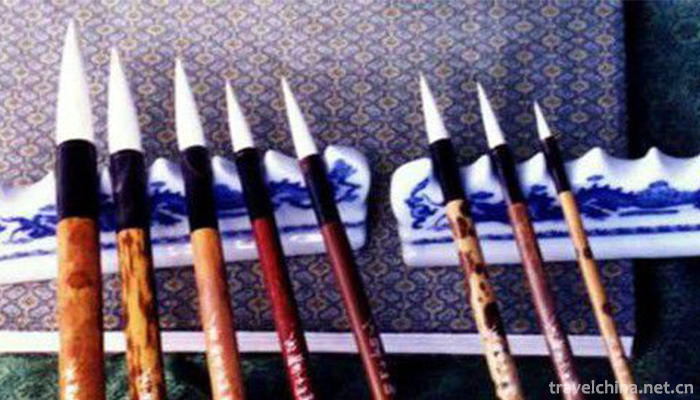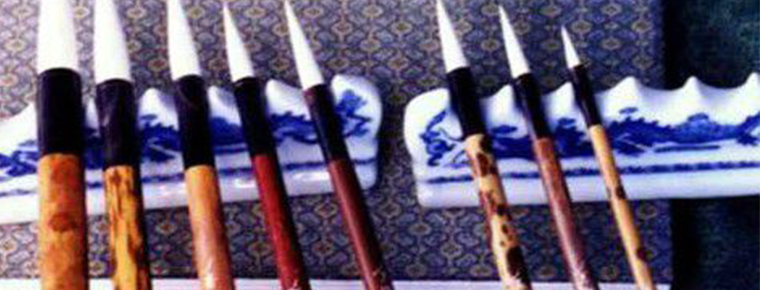Craftsmanship of Lake Pen
Craftsmanship of Lake Pen
Hubi craftsmanship, the traditional handicraft of Shanlian Town, Huzhou City, Zhejiang Province, is one of the national intangible cultural heritage.
The craftsmanship of Lake pen is made by hand, and the craftsmanship is very complicated. From the import of raw materials to the factory, it generally needs to go through twelve major processes, such as material selection, basin, knot, set, Pudun, mosaic, pen selection and engraving, which can be subdivided into more than 120 small processes. The craftsmen adhering to the "fine, pure and beautiful" criteria, produce "sharp, neat, round and healthy" finished Lake pens.
On May 20, 2006, the craftsmanship of Hubi was approved by the State Council and listed in the first batch of national intangible cultural heritage list. Item number_-72.
Historical origin
The birthplace of Hubi is Shanlian Town, Nanxun District, Huzhou City, 35 kilometers southeast of Huzhou City. Shanlian pen-making industry began in the Jin Dynasty. According to the Qing Dynasty Tongzhi's Huzhou Prefecture annals, it is stated that: (Shanlian) a good practitioner and the most sophisticated inhabitant make pens. He was built by Zhiyong Monk (a Sui Dynasty man, a famous King Faji, Wang Xizhi's seventh grandson). He traveled from Lianxi to Yongxin Temple in Jie'an, where his brushwork was gathered. After the development of Tang and Song Dynasties, Hubi has made great progress.
Chinese brushes originated very early, and "Hubi" was famous in the world, when it was in the Yuan Dynasty six or seven hundred years ago. Before the Yuan Dynasty, Xuanbi was the most famous in China. Both Su Dongpo and Liu Gongquan liked to use Xuanzhou pens; after Yuan Dynasty, Xuanbi gradually replaced Hubi, which established the position of the top brush. Hubi, together with Hui ink, Duanyan ink and Xuanjian paper, was called the "Four Treasures of the Study". According to the Record of Huzhou Prefecture, "In Yuan Dynasty, Feng Qingke and Lu Wenbao made pens, and their native habits were exquisite, so the name of Huzhou Pen was born in the world." "Huzhou Feng Bimiao is incomparable, as well as Shen Rixin, a skilled worker. If Yutang waved his hand, he would not hesitate to ask for a price like a pearl. People are willing to pay a lot of money for Lake pens, which shows their outstanding reputation.
The fame of Hu Pen is related to Zhao Mengfu, a calligrapher and painter of Yuan Dynasty. He is very concerned about and attaches great importance to the local techniques of making Hu Pen. According to the Records of Huzhou Prefecture, he once asked people to make his pen for him. Even if one is not satisfactory, he would break it down and reproduce it. The strict quality requirements have been handed down.
After liberation, the Party and the government adopted the policy of "protection, development and improvement" to the handicraft industry, including the Hubi industry. The old branches of the Hubi industry sprouted up and thrived again.
Inheritance and protection
Inheritance value
As the quintessence of Chinese culture, Hubi's exquisite craftsmanship demonstrates the extraordinary wisdom and skills of the working people, and is one of the models reflecting the outstanding creativity of the Chinese nation. The continuous progress of Hubi's craftsmanship has an important impact on the development of Chinese painting and calligraphy art and has promoted the artistic achievements of a large number of famous calligraphers and painters. The unique customs formed in the process of inheritance have a historical understanding of society. Value; the Lake pen culture with distinct regional characteristics, which enriches the connotation of Jiangnan culture, has become an important part of the excellent culture of the Chinese nation; the Lake pen craft has gone all over the country and gone abroad, which has a guiding role in the Chinese brush making skills, has a significant role in promoting cultural exchanges between China and foreign countries since ancient times, and in enhancing the cohesion of the world's descendants of the Yellow Emperor and the Yellow Emperor. Far reaching.
Inheritance status
The exquisite craftsmanship of Hubi is an important part of Hubi culture with distinct regional characteristics. However, the transformation of social culture, the innovation of writing tools and the one-sided pursuit of economic interests have led to the overflow of defective products, the loss of craftsmen and the lack of inheritance in the production of Lake pens. The traditional skills of Lake pens have been greatly impacted, and measures should be taken to protect them.
Inheriting characters
Qiu Changming, male, Han nationality, born in 1950, is from Shanlian Town, Huzhou City, Zhejiang Province. In May 2006, Hubi craftsmanship was listed in the first batch of national intangible cultural heritage list of traditional craftsmanship, project number_-72. In June 2007, Qiu Changming was selected as the representative successor of the first batch of national intangible cultural heritage projects and declared in Huzhou City, Zhejiang Province. Qiu Changming entered Shanlianhu Pen Factory at the age of 16. Yao Guanqing, the veteran artist of Hu Pen, was a teacher. He learned the recognized special skills of Hu Pen Industry. Qiu Changming is very skilled in pen-choosing. His pen is sharp and clear, with a clean top, no hairs and scraps, and his body is white, round and straight. Everyone who uses it feels comfortable and free.
protective measures
Huzhou has the Lake Pen Museum, which displays the past and present life of the Lake Pen in order to protect the culture of the Lake Pen.
Huzhou has held a large-scale Hubi Culture Festival since 2002, and it has been going on till now. Every year, Huzhou is moving toward the city. Schools here have calligraphy and painting classes, and after-school calligraphy and painting studios are full of streets and lanes.
In 1980, the State Bureau of Light Industry listed Shanlianhu Pen Factory as a key project of tapping potential, innovating and renovating, offering a discount loan of 200,000 yuan to renovate facilities.
In 1987, Shanghai Science and Education Film Studio came to Pulian to shoot the science and education film "Hu Bi", which lasted 20 minutes. It vividly described the Hu Bi and its production skills, and retained valuable literature.
Since 2001, Zhejiang Provincial Planning and Economic Commission has arranged special subsidies for the traditional arts and crafts industry. Shanlian Lake Pen Factory, Wang Yipinzhai Bizhuang and other key Lake pen enterprises can basically get tens of thousands of yuan of subsidies every year.
social influence
Important activities
Since 2001, Huzhou City has established the first "Huzhou International Hubi Culture Festival of China". Since then, Hubi Culture Festival has been held every two to three years, and has held five sessions by 2010. Hubi Culture Festival is the most representative and largest modern economic and cultural festival in Huzhou. It is named "Hubi", which reflects the importance and cherishing of the traditional cultural brand of "Hubi" by the Municipal Committee, the Municipal Government and the people of Huzhou. Every series of activities of Hubi Culture Festival contains contents related to the art of painting and calligraphy and Hubi. For example, the first Hubi Culture Festival held an international "Hubi Culture Forum", which received more than 100 papers and articles from 17 provinces, cities, regions and 7 countries such as the United States, Britain, France, Japan and Canada. More than 100 experts, scholars and guests from home and abroad attended the forum.
In 2005, the 3rd Hubi Culture Festival held "Hubi Famous Enterprises (Fang), Famous Articles, Famous Teachers" competitions and other activities.


-
1.Privacy Policy
We takes users' information safety and privacy as our lifeline. Based on our basic principle "Users' needs are our first priority", we are committed to enhancing the transparency of informat
Time 2018-12-08 -
2.Chuanlord Tourism & Leisure EXPO Park
Chuanlord Tourism & Leisure EXPO Park ,Changlu Tourism Xiubo Park, or Changlu Environmental Protection Holiday Farm (hereinafter referred to as "Changlu Farm")
Time 2018-12-12 -
3.Banyan Tree Shanghai On The Bund
Shanghai, one of the largest cities in the world, has a vibrant urban atmosphere, impressive urban skyline and rich and colorful culture. Located in the center of the city and resting on the Bank of H
Time 2018-12-16 -
4.Tea Picking Opera
Tea-picking opera is a kind of traditional opera popular in Jiangnan and Lingnan provinces. It was mostly produced from the middle of Qing Dynasty to the end of Qing Dynasty.
Time 2019-04-04 -
5.Ningbo Mud Golden Paint
Ningbo mud gold paint is a local traditional lacquerware process in Zhejiang Province. Chinese raw lacquer is the main raw material. Raw lacquer, also known as big lacquer and real lacquer,
Time 2019-06-07 -
6.Running curtain
Running curtain originated in the Spring and Autumn Period and Warring States Period, formed in the Qin and Han Dynasties, flourished in the Song, Yuan, Ming, Qing Dynasty and the early Republic of Ch
Time 2019-06-09 -
7.Yongkang Drum Ci
Yongkang Drum Ci is a rap art in Yongkang area of Zhejiang Province. It belongs to the form of singing and talking, which is mainly composed of singing. Because of the use of local dialect performance
Time 2019-07-14 -
8.Zhangjiajie Yangxi Opera
Zhangjiajie Yangxi Opera originated in the middle of Qing Dynasty and has a history of more than 300 years. It belongs to Beilu Yangxi Opera. The singing feature is the singing method of "golden
Time 2019-07-16 -
9.Chinese history
Chinese history From China Chinese civilization To the present history. China has a long history. Since the Huangdi tribe Ji Xuanyuan (also known as the Gong sun Xuanyuan) period has been counted for
Time 2019-08-28 -
10.Cao Zhi
Cao Zhi (192 - 232 December 27th), Zi Jian, Pei Guo Qiao County (now) Anhui province Bozhou City, born in East Wuyang (now Shenxian, Shandong, Juancheng). Cao Cao He was born with third sons from Quee
Time 2019-09-07 -
11.Taoping Qiang Village
Taoping Qiang village is located in Taoping Township, beside Zagunao River in Lixian County. Qiang village is 40 km away from Lixian City, 16 km from Wenchuan city and 139 km from Chengdu. It is a national key cultural relics protection unit and an important scenic spot in Jiuhuang line tourism circle.
Time 2020-11-07 -
12.Guangan landform
The topography of Guang'an City is fan-shaped distributed between the hills and parallel valleys in eastern Sichuan, which belongs to the Sichuan basin bottom extending to the basin periphery gradually. The Huaying mountains, which run through the so
Time 2020-12-19